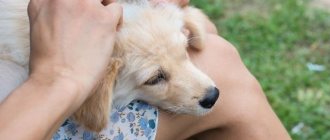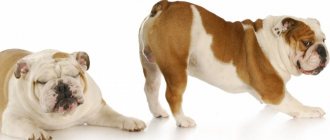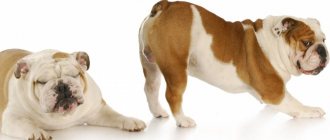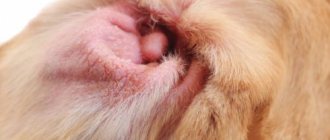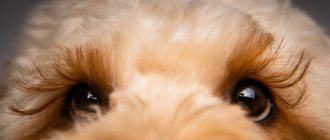Seasonal molting in animals is a sign of normal functioning of the body. Some breeds are characterized by year-round hair loss, while others experience hair loss in the off-season. Non-shedding species have been created that are important to cut and trim. But if the process leaves bald spots and causes itching, then this is a cause for concern: the dog is sick.
Classification of baldness
There is no generally accepted classification system for alopecia in pets; different sources divide the types of the disease in their own way. Experts agree that canine alopecia can be divided into three types, which also have their own subtypes:
- According to etiology, they are divided into 2 subtypes: inflammatory and non-inflammatory;
- Localization classification is divided into 4 subtypes: nested, telogen, mirror or multifocal;
- Genetics: hereditary and acquired (Alopecia X).
Veterinarians use this classification of the disease to make an accurate diagnosis in accordance with the standards.
How to relieve severe itching
Itching is a good reason to visit a veterinarian. If your pet starts itching after new food, shampoo, bedding, or the product you used to clean the house, then you need to return to the original food or detergents. Eliminating the source of the allergy or stress will normalize the animal’s condition in a couple of days.
You can get advice from a veterinarian and prescribe one of the antihistamines, for example, Suprastin or Tavegil. Or wait until the body copes with the allergy on its own, if there is no severe itching.
In the long term, antihistamines do not promote good immune system function. They act like turning off a fire alarm without affecting the fire itself. The second reason is parasites. Carefully examine the animal's fur. If you find fleas or lice, wash your dog with anti-flea shampoo “Fitoelita”, “Bars”, “Mr Bruno”, “Doctor Zoo”, “Clandestine”.
The next reason is inflammation. Wash the inflamed area with chamomile infusion or green tea with 1/2 teaspoon of apple cider vinegar. You can also apply a thick poultice of oatmeal to the itchy area. Now you have done everything you could. And if the problem persists, then after providing first aid to your pet and eliminating the most obvious causes of itching, you are ready to get an appointment with a veterinarian.
Causes of alopecia in dogs
Depending on the type of baldness, the disease can have completely different causes. The most common cause is considered to be problems with hormones, so alopecia in dogs is still conventionally divided into two subtypes: hormonal and non-hormonal. Only in 40% of cases, hair problems arise for other reasons.
Problems with hormones
According to the latest data from veterinary scientists, it has been established that hormonal hair loss in dogs is associated with genetic problems. The official name of the disease Alopecia X means that the mechanisms of development of problems and transmission through genes are not fully understood. Today, transmission through an autosomal dominant relationship is considered the most likely.
Most often, adult and elderly dogs suffer from endocrine alopecia.
Hormonal problems can be caused not only by hereditary factors, but also by acquired ones. The most common causes of hormonal problems that cause baldness are diseases such as hypothyroidism and hyperandrenocorticism. In the first case, alopecia develops due to insufficient production of thyroid hormones, in the second - increased levels of cortisol (Cushing's syndrome).
Most often, the endocrine nature of alopecia leads to baldness on the abdomen and hind limbs, chest, anus and genital area, and armpit.
Seasonal molt
Changing coats in dogs is a natural process. The condition is characterized by systematic loss of old hair at certain times of the year. Shedding usually happens twice a year, but there are breeds in which it happens a little more often. It is easy to distinguish seasonal molting from pathological baldness by characteristic signs:
- Uniform hair loss without bald spots or bald spots;
- After combing, you can notice better quality wool of shorter length;
- Seasonality - loss occurs in spring and autumn;
- The dog's behavior has not changed.
Read Causes and symptoms of strange breathing in dogs
When changing coat, the dog may itch a little; it is important not to confuse this symptom with the appearance of itching from other diseases. This process can be accelerated by systematically brushing the coat every day during the molting period.
Seasonal molting is not a disease and does not require any treatment. The hair loss should stop on its own within 2-3 weeks.
Poor nutrition
The cause of pet baldness can be an unbalanced diet with a lack of vitamins and minerals. Most often, coat problems appear in dogs that eat monotonous natural food. For healthy hair growth, the animal's body needs vitamins B and C.
Dogs that consume dry or canned food do not experience problems with hair loss due to a lack of vitamins. Typically, such feeding is saturated with useful substances.
Baldness after grooming
Dogs with hair growth problems experience problems with hair growth after clipping. In fact, slow coat growth is the first sign of accumulated problems. In this case, you need to contact a veterinary clinic and have your pet examined. The doctor will find out whether the lack of new hair is normal or a disease. If health problems are identified, it is necessary to change the animal’s diet and administer medication.
Allergic reactions
Allergic dogs suffer from patchy baldness due to the severe itching that accompanies the disease. The animal scratches the area of discomfort until bald patches appear. In this case, baldness is not due to hair growth problems, but is a secondary symptom of an allergy.
Allergies can be caused by food, pet care products, clothing materials, or seasonally flowering plants. In this case, the allergy is characterized by redness of the skin, and sometimes open wounds at the sites of irritation. The skin becomes dry and dandruff appears. It is difficult to identify the cause of an allergic reaction; you will need the help of a specialist.
Parasites
The presence of harmful parasites in the body often leads to thinning and hair loss in dogs. Alopecia develops as a consequence of helminthiasis, demodicosis, otodectosis or sarcoptic mange. In this case, parasites can be found both on the skin of the animal and in the internal organs.
Read Signs and how to treat allergies in chapei: 7 proven methods
Parasitic diseases lead to a general deterioration in the health of hair follicles. Often parasites lead to severe itching on the dog's skin. The pet begins to itch a lot and symptoms of alopecia areata appear.
Stress
Dogs, like people, can experience stress; Chihuahuas and Labradors are most susceptible to such disorders. As a result of stressful situations, the animal's body experiences a multicomponent reaction in response to severe stress. Scientists have proven that this condition of the animal can lead to hair loss, among other things (Yang EV, Glaser R., 2001). The causes of stress are:
- Moving;
- First visit to exhibitions and competitions;
- Aggression from humans or other dogs;
As a result of stressful situations, the mildest form of alopecia develops - diffuse. Symptoms of the disease may not be noticeable and everything will return to normal on its own. Complications can arise if the pet experiences stress very often.
Pregnancy
The period of gestation of puppies itself does not cause baldness. Pregnancy entails a lack of vitamins in the pet’s body, hormonal imbalances and stress. During this special period, the cause of baldness may be one of the factors or all together.
To avoid alopecia in a dog during pregnancy, you need to improve the animal’s nutrition and ensure a quiet life, without unnecessary stress and close attention, especially from children.
Vitamins and preparations for hair restoration
A healthy dog has a beautiful, thick, even coat with bright color and shine. To ensure your pet’s appearance remains impeccable, its cover must be carefully monitored:
- Bath and brush according to breed recommendations;
- Use only animal-friendly products;
- Follow a diet, choosing high-quality products and feeds without allergenic additives.
During the shedding period, be sure to brush your dog daily to get rid of dead hair. Without this procedure, the pores become clogged, which leads to itching and irritation. If any unhealthy signs appear: bald spots, redness, you need to go to the clinic.
Another factor influencing the health of the coat is the sufficiency of the vitamin complex. All puppies and adult dogs need mineral supplementation. If dry food includes the necessary vitamins, then special additives are introduced for natural nutrition.
There are industrial wool growth tablets and nutritional supplements:
- Vit active S-SH (increasing hair density, improving structure; preventing destruction of hair follicles);
- Beafar (vitamin complex for healthy dermis and coat);
- Excel 8 in 1 (combination of garlic and brewer's yeast);
- Varieties of vitamins Canina ;
- Feed molasses and liver, flaxseed oil, brewer's yeast, lamb, whey (vitamins B, H, F);
Symptoms of alopecia in dogs
Each type of alopecia has its own characteristics, and there is no single clinical symptomatology. Depending on the cause and type of hair loss, dogs suffer from the following symptoms:
- Baldness due to hormonal imbalance is characterized by uniform or focal hair loss, as well as hyperpigmentation (Alopecia X).
- Seasonal shedding is characterized by uniform thinning and hair loss, but not completely.
- An unbalanced diet leads to alopecia in the form of severe thinning of the coat.
- After grooming, the symptom will be that the coat does not recover for a month.
- Allergies are characterized by alopecia areata, sores and redness in areas of baldness.
- Parasitic baldness manifests itself focally, the dog makes bald patches by scratching.
- Stress baldness is characterized by uniform loss and thinning of a dog's hair.
- During pregnancy, hair falls out evenly and the hair becomes thin. After childbirth, the fur is gradually restored.
Differential diagnosis based on the symptoms of alopecia is impossible; to determine the causes and type of disease, you need to contact a veterinary clinic where research will be carried out.
Source of melatonin
Melatonin is easily synthesized and is therefore a fairly inexpensive hormone that is administered orally (as tablets or capsules) or systemically using subcutaneous injections or long-acting subcutaneous implants. Interestingly, melatonin is also present naturally in some plants. However, to absorb 3 mg of melatonin, you would need to eat 120 bananas or 30 large bowls of rice!
Melatonin tablets are sold over the counter in pharmacies and health products in the United States and some other countries, where it is considered more of a dietary supplement than a drug (so it is not regulated as such). Melatonin is available in 2 or 3 mg tablets under several trade names. However, only licensed products guarantee quality. Melatonin crystal powder is also made into capsules. The main problem with oral melatonin is its short half-life and dose-dependent bioavailability. In one study, after administration of 3 mg/kg IV, its half-life in dogs was 18.6 minutes. Thanks to the Rickards Research Foundation, injectable liquid melatonin (made from crystalline melatonin powder dissolved in ethanol and mixed with water and DMSO) has been available for several years. It has been used in the past to treat acanthosis nigricans (Scott et al., 1995). This could be a valuable option, although pharmacokinetic data on this are lacking. Long-acting implants containing 2.5 mg and 12 mg melatonin have been approved in several countries for use in mink and foxes, respectively. They are produced by WildlifePharmaceuticals. Unfortunately, some dogs that have received subcutaneous implants have developed sterile abscesses or granulomas at the implantation site. This is common in dogs; In the fur industry, more than 10 million minks and foxes received subcutaneous melatonin implants and there was no evidence of local adverse reactions.
Diagnostics
First of all, the veterinarian will perform an external examination of the dog and take an anamnesis. Next, the doctor will choose one of the diagnostic methods to detect alopecia in a pet:
- Biopsy;
- Phototrichogram;
- Glow with an ultraviolet lamp;
- Biochemical, mycological and bacteriological studies of skin scrapings;
- General analysis of blood, urine and feces.
Read Signs and treatment of ataxia in dogs: 3 types of disease
An ultrasound may be prescribed to examine the functioning of the thyroid gland. The activity of B- and T-lymphocytes in the blood, the content of antigens and protein are being studied.
Which breeds are more susceptible
Absolutely any dog can get sick, but dogs that are long-haired and have folds of skin along their body are more susceptible to baldness and coat problems. These are Mastino Napolitano, Bullmastiff, Dogue de Bordeaux, Chow Chow, Shar Pei, Boxer, English and French bulldogs, Pug, Chihuahua and some other breeds.
Due to their anatomy, large folds of skin can rot, accumulate infection, become inflamed and lead to the development of diseases in which the coat becomes very thin or falls out altogether.
Best Treatments
Based on the diagnostic results, the veterinarian must prescribe appropriate treatment for the dog. There are general recommendations that are aimed at stimulating hair growth in dogs:
- Give the dog stimulating vitamins (Velkot, Polidex Super Wool);
- Increase the frequency of bathing your pet up to once a week;
- Masks of castor and burdock oil with egg yolks.
You should not give your dog human medications to stimulate hair growth (such as Minoxidil). The consequences of using such drugs can lead to the death of the animal.
After poor nutrition
Alopecia after an unbalanced diet requires a gradual increase in nutrients in the diet. Veterinarians recommend starting to give your dog fish oil, dairy products, seafood, and adding olive and flaxseed oil to his food. Vitamin complexes containing vitamin A can also be prescribed.
Treatment of hereditary hormonal alopecia
A genetic predisposition to baldness is formed due to hormonal problems. Therapy is carried out accordingly with hormones. The effectiveness of this therapy is low, so it is used in combination with the use of hair growth stimulating agents.
Contact or food dermatitis
This type of alopecia has an allergic etiology and side effects. It is treated with a complex of drugs prescribed by a veterinarian:
- Antihistamines (Diazolin, Diphenhydramine, Suprastin);
- Antiseptic ointments (Ranosan, Saphroderm, Septogel);
- Eliminating the allergen.
The use of such a complex of therapeutic measures helps eliminate the symptoms of baldness after 2-3 weeks. In advanced cases, independent treatment is impossible; the dog remains in the hospital.
Treatment for hair loss due to infection
The treatment regimen depends entirely on the type of infection that led to baldness. First of all, treatment is aimed at eliminating foreign bacteria, fungi and viruses from the body. Treatment is carried out with antiviral drugs.
Therapy for baldness from parasites
Treatment is aimed at eliminating helminths from the pet’s body that cause coat problems. Antiseptics are used to eliminate itching and prevent scratching. Further treatment is carried out using antiparasitic agents for animals, bathing, and enemas.
Prevention
To keep your pet's fur healthy, it is necessary to balance the dog's diet and enrich the diet with bioactive additives (fatty acids, B vitamins, amino acids, brewer's yeast, biotin). Also, we must not forget about activity. Your pet needs fresh air, active walks, games and attention from the owner. Do not forget to periodically thoroughly comb the dog, inspect the integrity of the skin and monitor the general condition of the animal. There are special vitamin and mineral complexes to improve the quality of dog fur.
Possible complications
Any disease, if left untreated or if it is chosen incorrectly, can become complicated. In the case of skin diseases with infection, this threatens the dog with the spread of the disease, including general blood poisoning.
If the cause of hair loss is a food allergy, continuing to feed your dog the same food can be fatal. This will lead to disruption of the functioning of internal organs, digestive disorders and the most dangerous consequences, including death.
Extensive damage to the dog’s fur threatens the development of severe infections and their spread throughout the body.
What to do at home
The dog should be treated only as prescribed by a doctor, without doing anything on your own. At home, a sick dog needs to be provided with a dry, clean and warm place where no one will disturb it. The bedding must be changed regularly, washed thoroughly and ironed if a tick or fungal or bacterial infection is detected on the dog.
Medicines are given as prescribed by the veterinarian. The dog is provided with high-quality food, clean water, and care is taken to ensure that it does not become depressed or experience severe discomfort.
If the animal scratches its wounds, it will have to wear a special protective collar. Owners will have to carefully treat diseased areas of the skin in order to quickly achieve healing and the growth of a healthy shiny coat.
